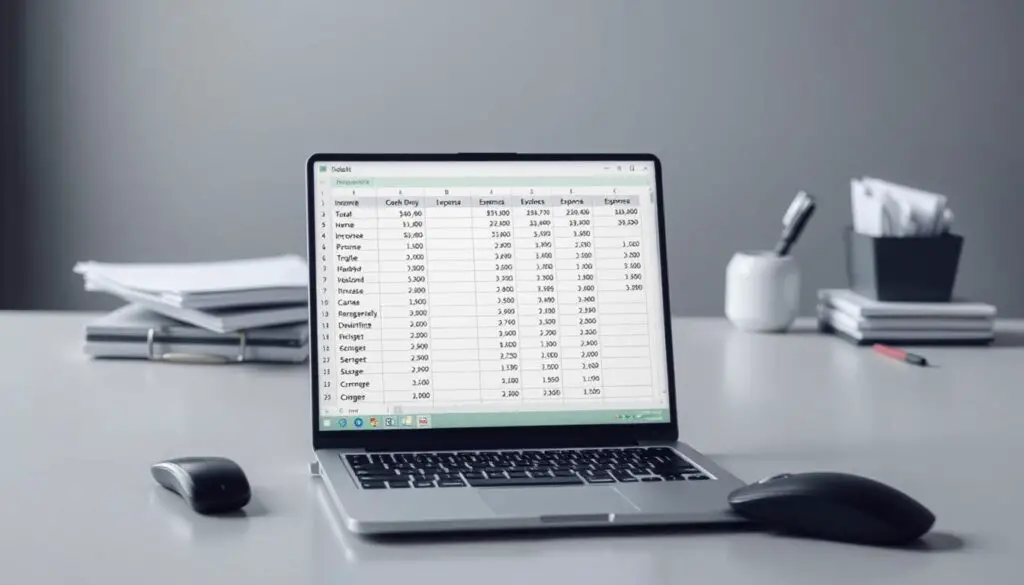Ever felt like money controls you instead of the other way around? I used to live paycheck to paycheck, worried about where my money went each month. Then, I found the power of personal finance and budgeting for beginners.
Budgeting isn’t about cutting down your life. It’s about unlocking your financial potential. With the right steps, you can make your financial dreams real. These first steps will help you feel more financially secure.
Learning to budget is like learning a new language the language of financial freedom. It lets you make smart money choices, track your spending, and secure your financial future. Don’t let numbers scare you; this guide will make budgeting simple and easy.
Key Takeaways
- Budgeting helps you understand and control your financial situation
- Personal finance basics are essential for long-term financial success
- Creating a budget is easier than you might think
- Financial freedom starts with understanding your income and expenses
- Small, consistent steps lead to significant financial improvements
Understanding the Basics of Personal Finance

Personal finance is a key skill for a better financial future. Learning money management and financial literacy are essential steps. It’s not just about earning and spending. It’s about making smart choices for your long-term financial health.
What is a Budget and Why You Need One
A budget is your financial guide, helping you track your money. It’s like a personal financial plan that lets you control your finances. With a budget, you can:
- Identify unnecessary spending
- Plan for future financial goals
- Reduce financial stress
- Build emergency savings
The Psychology of Money Management
Your money choices are linked to your emotions and past. Understanding these patterns helps you make better money decisions. Knowing what triggers spending or anxiety is key to good money management.
Building Financial Literacy Foundation
Financial literacy means knowing enough to make smart money choices. Start with the basics like:
- Understanding credit scores
- Learning about investment options
- Tracking personal expenses
- Setting realistic financial goals
Building financial literacy is a journey. Every step you take gets you closer to financial confidence and stability.
Calculating Your After-Tax Income

Starting a budget plan means knowing your real income. Your after-tax income is the money you can spend and save. It’s more than your gross salary; it’s what you actually get to keep.
To figure out your after-tax income, you need to look at all your income sources. Your mindset should be on tracking all earnings, such as:
- Regular paycheck from primary job
- Freelance or contract work earnings
- Investment dividends
- Side hustle revenue
- Rental income
To find your take-home pay, subtract important deductions from your gross income. These usually include:
- Federal income tax
- State and local taxes
- Social Security contributions
- Medicare withholdings
- Retirement account contributions
Tip: Use your recent pay stubs or online payroll system for exact figures. Digital tools can make this easier and more accurate. Knowing your after-tax income is key to good financial planning and budgeting.
Essential Components of Budgeting for Beginners
Creating a successful budget is all about understanding the basics. It’s about tracking your spending and setting financial goals. These skills help you manage your money and secure a stable financial future.
Your budget is more than just numbers. It’s a guide for your financial decisions. It helps you reach your personal financial goals.
Fixed vs. Variable Expenses
Knowing the difference between fixed and variable expenses is key:
- Fixed Expenses: Monthly costs that stay the same
- Rent or mortgage payments
- Car payments
- Insurance premiums
- Loan repayments
- Variable Expenses: Costs that change each month
- Groceries
- Utilities
- Entertainment
- Dining out
Income Sources and Documentation
It’s important to document your income accurately. This helps you set financial goals. Include all income sources, such as:
| Income Type | Examples | Frequency |
|---|---|---|
| Primary Job | Salary, Regular Wages | Bi-weekly/Monthly |
| Secondary Income | Freelance Work, Side Hustles | Variable |
| Passive Income | Investments, Rental Income | Monthly/Quarterly |
Setting Realistic Financial Goals
When setting financial goals, use the SMART framework. This ensures your goals are realistic:
- Specific: Clearly define your goal
- Measurable: Set clear criteria for measuring progress
- Achievable: Make sure your goal is challenging but possible
- Relevant: Align your goal with your financial vision
- Time-bound: Set a realistic timeline for achieving your goal
Mastering these budgeting components helps you take control of your finances. You’ll make better decisions about your money.
The 50/30/20 Budget Rule Explained
Creating a budget can seem daunting, but the 50/30/20 rule makes it easier. It divides your after-tax income into three parts. This makes planning your finances simpler.
Let’s look at what each part of the budget rule is for:
- 50% for Needs: These are the things you must have to live.
- 30% for Wants: This is for things that make life better but aren’t essential.
- 20% for Savings: This goes toward saving for the future and emergencies.
The 50% for needs covers important costs like:
- Rent or mortgage payments
- Utilities
- Groceries
- Health insurance
- Transportation costs
The 30% for wants lets you enjoy life. It’s for entertainment, dining out, and personal treats. This part ensures you’re not just getting by, but also enjoying life.
The 20% for savings is key for financial security. It’s for emergency funds, retirement, paying off debt, and investing. By setting aside this amount, you’re securing your financial future.
Keep in mind, the 50/30/20 rule is just a starting point. Your situation might need some tweaks. But it’s a great way to start budgeting effectively.
Creating Your First Budget Plan
Making a budget plan is key to financial success. It helps you understand where your money goes and control your finances. Whether you’re fresh out of college or want to better your financial health, a good budget can change how you view money.
To start tracking your expenses, you need the right tools and strategies. Your budget journey starts with picking a method that fits your life and goals.
Choosing the Right Budgeting Tools
There are many ways to track your expenses:
- Smartphone apps that track expenses in real-time
- Spreadsheet templates for detailed financial planning
- Online banking tools for financial management
- Dedicated budgeting software with lots of features
Digital vs. Paper Tracking Methods
Think about these differences when choosing how to track your expenses:
| Digital Methods | Paper Methods |
|---|---|
| Automatic categorization | Personal hands-on approach |
| Instant calculations | Better for visual learners |
| Cloud synchronization | No technology dependency |
Common Budgeting Mistakes to Avoid
Avoid these common budgeting mistakes:
- Underestimating variable expenses
- Forgetting irregular costs
- Not adjusting your budget monthly
- Failing to track small purchases
Pro tip: Start simple and be consistent with tracking expenses. Your first budget doesn’t need to be perfect – it just needs to be a start.
Smart Strategies for Expense Tracking
Tracking your expenses is key to good money management. Without knowing where your money goes, making a budget is hard. A good system for tracking expenses can improve your financial health and help you spend smarter.
First, pick the best tracking method for you. Today, there are many ways to track expenses:
- Mobile budgeting apps that sort transactions for you
- Spreadsheets for detailed expense logs
- Looking at your bank statements
- Keeping receipts and entering them manually
The secret to good expense tracking is consistency. Choose a method that fits your life and stick with it. Apps like Mint, YNAB, or Personal Capital can make tracking easier by automatically sorting your transactions.
When tracking, make sure to use detailed categories. This way, you can see where your money is going. Use categories like:
- Housing
- Transportation
- Food
- Entertainment
- Personal care
- Utilities
Regularly check your expense tracking to spot spending patterns and save money. Set aside time each week or month to review your spending. This will help you make better financial choices and adjust your budget as needed.
Building an Emergency Fund
An emergency fund is key to personal finance basics. It gives you financial security and peace of mind. It helps you handle unexpected expenses or income drops without ruining your financial plan.
How Much to Save
Figuring out how much to save for your emergency fund depends on your situation. Experts say to save 3-6 months of living costs. Your exact amount might change based on:
- Job stability
- Number of income earners in your household
- Type of employment (freelance, contract, full-time)
- Current financial obligations
Where to Keep Your Emergency Money
It’s important to choose the right place for your emergency fund. Go for a high-yield savings account that has:
- Easy access
- Good interest rates
- No penalties for withdrawals
- FDIC insurance
Making Regular Contributions
Consistency is key for your emergency fund savings. Start with a small part of your income each month. Automating your savings helps it grow steadily. Even $25-$50 a month can add up over time.
Building an emergency fund is a long-term effort. Stick to your personal finance basics. You’ll create a strong financial safety net that guards you against unexpected money troubles.
Automating Your Savings and Bill Payments
Using automation makes managing money easier. Automatic savings can change how you handle money. It takes away the need to track everything manually, helping you reach your financial goals.
Automating your savings is a smart way to grow your wealth. Banks and apps make it easy to set up automatic transfers. This way, you won’t forget to save and can avoid spending money meant for the future.
- Automate retirement contributions through workplace 401(k) plans
- Schedule monthly transfers to emergency fund accounts
- Set up automatic bill payments to avoid late fees
- Use round-up savings apps that transfer spare change automatically
Start small with automated savings. Experts suggest starting with 5-10% of your income. Then, increase it as you get more comfortable with your budget.
Digital banking makes it easy to follow money management tips. Use apps that track your automated savings. This way, you can see how you’re doing without doing anything extra.
But remember, automation isn’t a one-time thing. Check your systems often to make sure they still fit your financial plans and goals.
Dealing with Debt While Budgeting
Managing debt is key to personal finance basics. It can feel like a mountain, but with a good plan, you can conquer it. This way, you can reduce your debt and take control of your money.
When you make your budget, paying off debt should be top on your list. The right strategy can help you become debt-free faster.
Prioritizing Debt Payments
Not all debts are the same. Start with the ones that cost the most in interest. This can save you a lot of money.
- Target credit card balances with the highest interest rates
- Make minimum payments on all debts
- Allocate extra funds to the most expensive debt
Debt Reduction Strategies
There are two main ways to tackle debt:
- Debt Snowball Method: Pay off smallest debts first for quick wins
- Debt Avalanche Method: Focus on highest interest rates to save money long-term
| Method | Approach | Psychological Impact |
|---|---|---|
| Snowball | Smallest balances first | Quick motivation |
| Avalanche | Highest interest first | Maximum financial savings |
Balance Transfer Options
Balance transfer credit cards can help a lot. Look for ones with 0% introductory APR. This can lower your interest and speed up paying off debt.
Success in managing debt comes from being consistent and committed. Keep track of your progress and celebrate your wins. This will help you stay on track.
Making Your Budget Sustainable
Creating a sustainable budget is more than just numbers. It’s about being flexible and adapting to life’s surprises. Good money management means having a plan that can change with you.
Good budgeting means checking in often and being honest with yourself. Think of your budget as a living thing that needs updates. Set aside time each month to look at your finances, see what’s working, and what’s not.
- Track your spending meticulously
- Review financial goals quarterly
- Adjust budget categories as needed
- Celebrate small financial wins
Staying motivated is key to long-term financial success. Visualize your financial goals and break them into smaller steps. When unexpected costs come up, don’t get down. Being resilient helps keep your budget on track.
| Budget Review Frequency | Recommended Actions |
|---|---|
| Monthly | Categorize expenses, track spending patterns |
| Quarterly | Reassess financial goals, adjust strategy |
| Annually | Comprehensive financial health check |
A sustainable budget isn’t about being perfect. It’s about having a realistic plan that supports your goals and keeps your finances stable.
Conclusion
Learning to budget is more than just keeping track of money. It’s about taking control of your financial future and changing how you see money. The basics of personal finance are simple when you take it one step at a time.
Your journey with budgeting will change as you learn and grow. Every month, you’ll get new insights and chances to improve your financial plan. Remember, budgeting is about making steady progress, not being perfect. Even small changes can make a big difference over time.
Use what you’ve learned and start using these strategies today. Your future self will thank you for the discipline and planning you’re building now. Budgeting helps you make smart choices, lowers financial stress, and sets you up for long-term success.
Begin with small steps, stay dedicated, and see your financial confidence grow. With time and effort, budgeting will become a powerful tool for your financial success.


2 thoughts on “Budgeting for Beginners: The First 5 Steps”
Comments are closed.